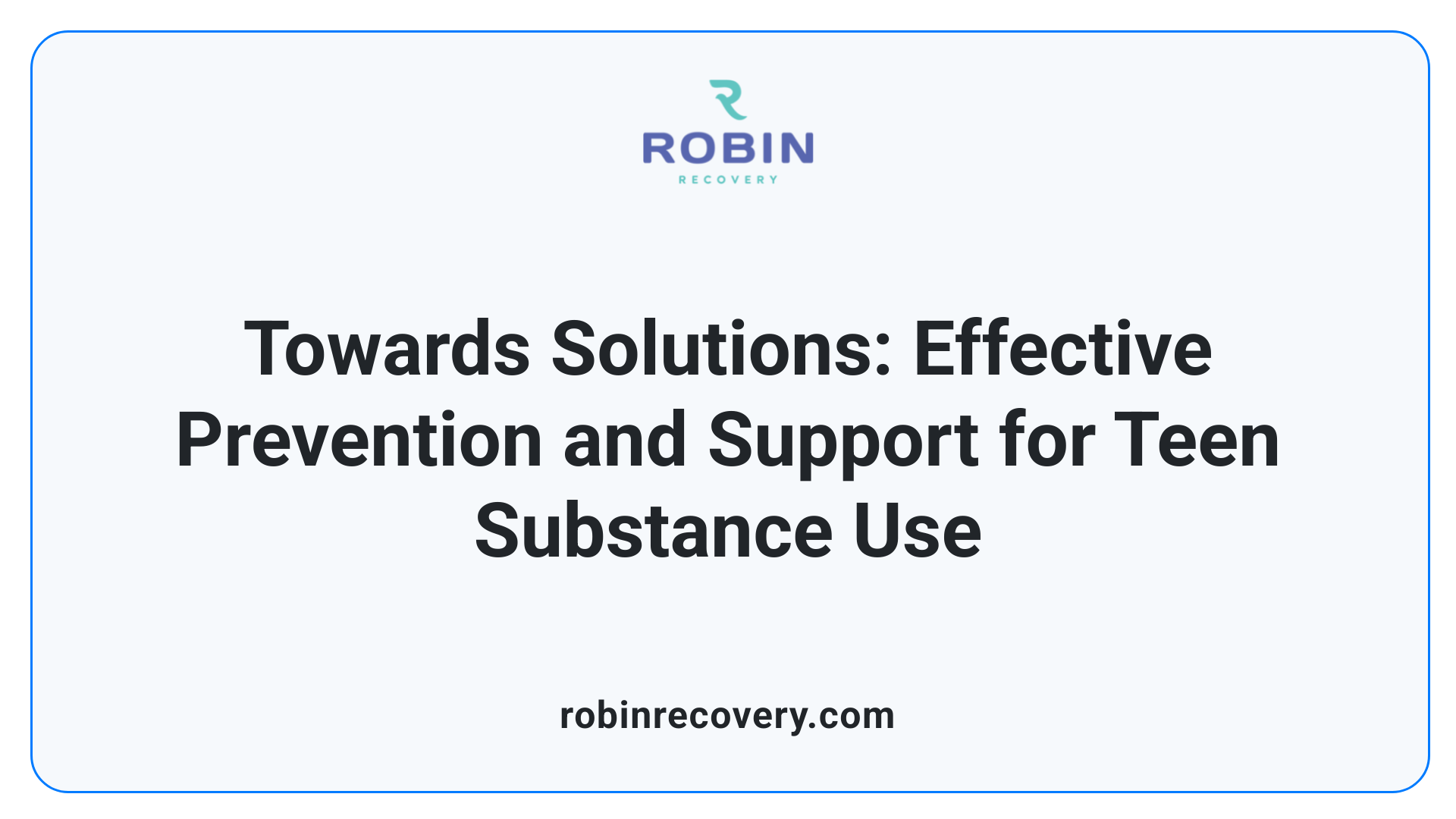New Study Shows Alarming Information About Daily Adolescent Substance Use

Understanding the Landscape of Teen Substance Abuse
Recent studies have brought to light concerning trends in adolescent substance use, revealing that while certain substance use has decreased, other patterns have emerged that suggest ongoing challenges. This narrative explores the complexities of substance abuse among teens, highlighting the varying forms of substance use, its effects, and potential preventative measures to combat these issues.
Substance Use Effects on Adolescents

How does substance use affect adolescents?
Substance use among adolescents can lead to numerous detrimental effects, including significant academic challenges. Students who engage in substance abuse are likely to experience lower grades, increased absenteeism, and a higher likelihood of dropping out of school. Research indicates a strong correlation between substance abuse and elevated truancy rates due to diminished commitment to education.
Mental health challenges are also pronounced. Adolescents who misuse substances are at a heightened risk for developing issues such as depression and suicidal tendencies. They may experience acute health crises due to accidents or overdoses. Indeed, recent surveys suggest that one in eight teenagers reported abusing illicit substances in the past year, highlighting the urgent need for intervention.
Additionally, substance abuse can create substantial family dysfunction, impacting relationships with parents and siblings. This can lead to increased stress within the household and potentially higher rates of involvement with the juvenile justice system. The economic costs are significant as well, with community resources strained by the aftermath of adolescent substance abuse.
In summary, the social and economic implications extend beyond the individual, affecting families and communities alike. Effective treatment and prevention measures tailored to youth are essential in addressing this ongoing crisis.
Most Abused Substances Among Teens

What substance is most abused by adolescents?
Adolescents are most likely to abuse alcohol, using it more than any other substance, including tobacco and marijuana. Recent statistics show a remarkable decline in alcohol use among 12th graders, dropping from 51.9% in 2022 to 45.7% in 2023. Binge drinking remains particularly concerning as it leads to severe health risks, including injuries and addiction.
Vaping versus traditional tobacco
Tobacco use is gradually declining among adolescents, yet vaping is on the rise. In 2023, nicotine vaping among 12th graders declined to 23.2%, down from 27.3% in 2022. This trend indicates a shift towards e-cigarettes over traditional cigarettes, which now face declining popularity among youth. This transition represents new health challenges, especially since vaping can lead to nicotine addiction.
Marijuana use trends
Marijuana continues to be the most commonly used illicit drug among adolescents. In 2023, 29% of 12th graders reported past-year marijuana use. Cannabis's stable use rates indicate that while adolescents are exposed to marijuana, factors like strong family connections and educational outreach about substance safety may help mitigate the risks associated with its usage.
Substance Trend Over Time Current Usage by 12th Graders Alcohol Declined from 51.9% (2022) to 45.7% (2023) 45.7% Nicotine Vaping Declined from 27.3% (2022) to 23.2% (2023) 23.2% Marijuana Stable at 29% (2023) 29%
Addiction and Abuse in the Teenage Years

What is the current research saying about addiction abuse in adolescence?
Current research highlights a critical period for substance use during adolescence, as many teens initiate use of various substances. Statistics reveal that 64% of 18-year-olds have tried alcohol, 45% have experimented with marijuana, and approximately 31% have smoked cigarettes. Although not all adolescents develop addiction, around 15% meet the criteria for alcohol abuse and 16% for drug abuse by the age of 18.
Neurobiological changes that occur during teenage years increase vulnerability to substance use. These changes can be influenced by external factors, including peer pressure and pre-existing mental health issues. As adolescents seek ways to feel relaxed or cope with stress, the risk of developing substance use disorders rises.
Effective prevention strategies focusing on education and support are crucial. Interventions that are school-based and family-centered have proven to be beneficial, but achieving long-term abstinence remains challenging. The concerning rise in e-cigarette usage among teens further complicates these efforts, indicating an urgent need for targeted programs to address and mitigate the ongoing issue of adolescent substance abuse.
Substance Type Percentage of 12th Graders Reporting Use Abuse Criteria by Age 18 Alcohol 45.7% (2023) 15% Marijuana 29.0% (2023) 16% Cigarettes 31% N/A
Mental Health and Substance Use Interconnection

What is the relationship between mental illness and substance use?
The relationship between mental illness and substance use is complex and deeply interlinked. Numerous individuals resort to substances as a means of self-medication for mental health issues such as anxiety, depression, and PTSD. This has led to a significant concern about the prevalence of co-occurring disorders, where Substance Use Disorder (SUD) often coincides with mental health disorders like depression and schizophrenia. Such dual challenges can severely impair daily functioning and quality of life.
Treatment approaches addressing both issues
Effective treatment for individuals experiencing both mental health issues and substance use requires an integrated approach. Various behavioral therapies, including Cognitive Behavioral Therapy (CBT) and Dialectical Behavior Therapy (DBT), have shown promise in treating both SUD and mental health conditions. These methods focus not only on substance use but also on underlying mental health issues, aiming for holistic recovery. Additionally, medication can aid in managing both addiction and mental health symptoms, emphasizing the importance of proper diagnosis and tailored treatment strategies.
Understanding the interplay between mental health and substance use is increasingly vital. Research from organizations like the National Institute of Mental Health (NIMH) provides valuable insights and resources, guiding individuals towards effective support and intervention strategies.
Emerging Trends and Alarming Findings
Introduction of delta-8-THC
In 2023, for the first time, the use of delta-8-THC among 12th graders was measured, with 11.4% reporting use. This marks the emergence of new cannabis-related trends among adolescents, indicating a shift in preferences towards variations of THC that may not be as widely regulated as traditional cannabis. Understanding the consumption patterns across different age groups is critical in addressing the potential health impacts and necessary interventions.
Stable yet Concerning Usage Rates
While drug use among eighth (10.9%), tenth (19.8%), and twelfth graders (31.2%) remains below pre-pandemic levels, the stability of these rates still raises concerns. The significant portion of adolescents engaging in substance use reflects ongoing public health challenges. Despite some encouraging declines in alcohol and nicotine vaping—where 12th-grade vaping dropped from 27.3% in 2022 to 23.2% in 2023—the persistent levels of cannabis and illicit drug use signal a need for continued vigilance.
Role of Social Media
The influence of social media cannot be overlooked in shaping adolescents' perceptions of substance use. Exposure to drug-related content has been linked to increased likelihood of teens trying nicotine products. As platforms evolve, this exposure requires thoughtful education strategies that promote informed choices, fostering environments where adolescents understand the risks associated with substance use.
Innovative Prevention and Intervention Strategies

Harm Reduction Programs
Harm reduction strategies are gaining traction as effective methods for preventing adolescent substance abuse. Programs are designed to reduce the negative consequences of drug use rather than solely promoting abstinence. For instance, initiatives that distribute naloxone, an opioid overdose reversal drug, empower young people to respond to overdose situations effectively. Additionally, courses that educate adolescents on safe drug use practices and risk awareness help promote informed decisions about substance use.
Effective Educational Approaches
Recent shifts away from the traditional "Just Say No" campaigns towards the "Just Say Know" approach have proven more productive. This method emphasizes education about the risks associated with substance use, enabling teens to make informed choices. Engaging discussions in school curricula on the dangers of smoking, drinking, and drug use help demystify these substances, equipping students with the knowledge needed to navigate peer pressures.
Role of Family and Community
Strong familial ties and community support are critical in keeping youth substance-free. Programs that enhance parent-teen communication, coupled with community-focused initiatives, have shown success. Families that set clear expectations and provide guidance can discourage substance use more effectively. Community efforts, such as organized recreational activities and support groups, foster healthy alternatives to substance use among adolescents.
Towards an Informed Approach to Adolescent Substance Use
With a growing body of research uncovering the multifaceted nature of adolescent substance use, the need for comprehensive, informed approaches to prevention and intervention has never been more essential. By understanding the underlying motivations and social influences, alongside innovative educational and community-based strategies, stakeholders can work effectively to mitigate the risks associated with substance use during these critical developmental years. Moving forward, an emphasis on integrating physical and mental health care, fostering strong family connections, and harnessing the power of targeted prevention programs will be crucial in safeguarding the health and wellbeing of the next generation.
References
- Reported drug use among adolescents continued to hold below pre ...
- More teens than ever are overdosing. Psychologists are leading ...
- Teenage Drug Use Statistics [2023]: Data & Trends on Abuse
- Most reported substance use among adolescents held steady in 2022
- Stress driving substance use in American teens, study finds
- Alcohol, e-cigarettes, cannabis: concerning trends in adolescent ...
- Characteristics of Alcohol, Marijuana, and Other Drug Use Among ...
- Youth Drug Use Continues Historic Decline Post Pandemic
- Disturbing Findings: Child Drug Use Vastly Underestimated
- Substance Use in Adolescence | HHS Office of Population Affairs
